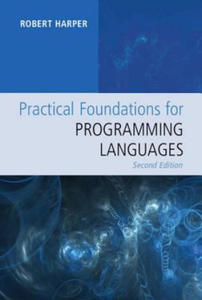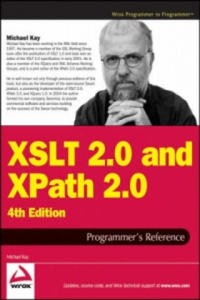libristo foundations of programming languages 18344665
- znaleziono 11 produktów w 3 sklepach
Practical Foundations for Programming Languages Cambridge University Press
Książki / Literatura obcojęzyczna
This text develops a comprehensive theory of programming languages based on type systems and structural operational semantics. Language concepts are precisely defined by their static and dynamic semantics, presenting the essential tools both intuitively and rigorously while relying on only elementary mathematics. These tools are used to analyze and prove properties of languages and provide the framework for combining and comparing language features. The broad range of concepts includes fundamental data types such as sums and products, polymorphic and abstract types, dynamic typing, dynamic dispatch, subtyping and refinement types, symbols and dynamic classification, parallelism and cost semantics, and concurrency and distribution. The methods are directly applicable to language implementation, to the development of logics for reasoning about programs, and to the formal verification language properties such as type safety. This thoroughly revised second edition includes exercises at the end of nearly every chapter and a new chapter on type refinements.
Sklep: Libristo.pl
Practical Foundations For Programming Languages
Książki Obcojęzyczne>Angielskie>Computing & information technology>Computer programming / software development>Programming & scripting lan...
0x007dd6fb00000000
Sklep: Gigant.pl
Foundations of Quantum Programming Elsevier Science & Technology
Książki / Literatura obcojęzyczna
Foundations of Quantum Programming discusses how new programming methodologies and technologies developed for current computers can be extended to exploit the unique power of quantum computers, which promise dramatic advantages in processing speed over currently available computer systems. Governments and industries around the globe are now investing vast amounts of money with the expectation of building practical quantum computers. Drawing upon years of experience and research in quantum computing research and using numerous examples and illustrations, Mingsheng Ying has created a very useful reference on quantum programming languages and important tools and techniques required for quantum programming, making the book a valuable resource for academics, researchers, and developers. Demystifies the theory of quantum programming using a step-by-step approachCovers the interdisciplinary nature of quantum programming by providing examples from many different fields including, engineering, computer science, medicine, and life sciencesIncludes techniques and tools to solve complex control flow patterns and synchronize computationsPresents a coherent and self-contained treatment that will be valuable for academics and industrial researchers and developers
Sklep: Libristo.pl
Foundations Of Logic Programming
Książki Obcojęzyczne>Angielskie>Computing & information technology>Computer science>Mathematical theory of computationKsiążki Obcojęzyczne...
0x002e03cb00000000
Sklep: Gigant.pl
Foundations Of Software Engineering
Książki Obcojęzyczne>Angielskie>Computing & information technology>Computer programming / software development>Programming & scripting lan...
0x0081058b00000000
Sklep: Gigant.pl
Beginning Programming with Python For Dummies, 3rd Edition John Wiley & Sons Inc
Książki / Literatura obcojęzyczna
Create simple, easy programs in the popular Python languageBeginning Programming with Python For Dummies is the trusted way to learn the foundations of programming using the Python programming language. Python is one of the top-ranked languages, and there's no better way to get started in computer programming than this friendly guide. You'll learn the basics of coding and the process of creating simple, fun programs right away. This updated edition features new chapters, including coverage of Google Colab, plus expanded information on functions and objects, and new examples and graphics that are relevant to today's beginning coders. Dummies helps you discover the wealth of things you can achieve with Python.* Employ an online coding environment to avoid installation woes and code anywhere, any time* Learn the basics of programming using the popular Python language* Create easy, fun projects to show off your new coding chops* Fix errors in your code and use Python with external data setsBeginning Programming with Python For Dummies will get new programmers started--the easy way.
Sklep: Libristo.pl
XSLT 2.0 and XPath 2.0 Programmer's Reference 4e John Wiley & Sons Inc
Książki / Literatura obcojęzyczna
This book is primarily a practical reference book for professional XSLT developers. It assumes no previous knowledge of the language, and many developers have used it as their first introduction to XSLT; however, it is not structured as a tutorial, and there are other books on XSLT that provide a gentler approach for beginners. The book does assume a basic knowledge of XML, HTML, and the architecture of the Web, and it is written for experienced programmers. There's no assumption that you know any particular language such as Java or Visual Basic, just that you recognize the concepts that all programming languages have in common. The book is suitable both for XSLT 1.0 users upgrading to XSLT 2.0, and for newcomers to XSLT. The book is also equally suitable whether you work in the Java or .NET world. As befits a reference book, a key aim is that the coverage should be comprehensive and authoritative. It is designed to give you all the details, not just an overview of the 20 percent of the language that most people use 80 percent of the time.It's designed so that you will keep coming back to the book whenever you encounter new and challenging programming tasks, not as a book that you skim quickly and then leave on the shelf. If you like detail, you will enjoy this book; if not, you probably won't. But as well as giving the detail, this book aims to explain the concepts, in some depth. It's therefore a book for people who not only want to use the language but who also want to understand it at a deep level. The book aims to tell you everything you need to know about the XSLT 2.0 language. It gives equal weight to the things that are new in XSLT 2.0 and the things that were already present in version 1.0. The book is about the language, not about specific products. However, there are appendices about Saxon (the author's own implementation of XSLT 2.0), about the Altova XSLT 2.0 implementation, and about the Java and Microsoft APIs for controlling XSLT transformations, which will no doubt be upgraded to handle XSLT 2.0 as well as 1.0. A third XSLT 2.0 processor, Gestalt, was released shortly before the book went to press, too late to describe it in any detail. But the experience of XSLT 1.0 is that there has been a very high level of interoperability between different XSLT processors, and if you can use one of them, then you can use them all.In the previous edition we split XSLT 2.0 and XPath 2.0 into separate volumes. The idea was that some readers might be interested in XPath alone. However, many bought the XSLT 2.0 book without its XPath companion and were left confused as a result; so this time, the material is back together. The XPath reference information is in self-contained chapters, so it should still be accessible when you use XPath in contexts other than XSLT. The book does not cover XSL Formatting Objects, a big subject in its own right. Nor does it cover XML Schemas in any detail. If you want to use these important technologies in conjunction with XSLT, there are other books that do them justice. This book contains twenty chapters and eight appendixes (the last of which is a glossary) organized into four parts. The following section outlines what you can find in each part, chapter, and appendix. Part I: Foundations: The first part of the book covers essential concepts. You should read these before you start coding.If you ignore this advice, as most people do, then you read them when you get to that trough of despair when you find it impossible to make the language do anything but the most trivial tasks. XSLT is different from other languages, and to make it work for you, you need to understand how it was designed to be used. Chapter 1: XSLT in Context: This chapter explains how XSLT fits into the big picture: how the language came into being and how it sits alongside other technologies. It also has a few simple coding examples to keep you alert. Chapter 2: The XSLT Processing Model: This is about the architecture of an XSLT processor: the inputs, the outputs, and the data model. Understanding the data model is perhaps the most important thing that distinguishes an XSLT expert from an amateur; it may seem like information that you can't use immediately, but it's knowledge that will stop you making a lot of stupid mistakes. Chapter 3: Stylesheet Structure: XSLT development is about writing stylesheets, and this chapter takes a bird's eye view of what stylesheets look like.It explains the key concepts of rule-based programming using templates, and explains how to undertake programming-in-the-large by structuring your application using modules and pipelines. Chapter 4: Stylesheets and Schemas: A key innovation in XSLT 2.0 is that stylesheets can take advantage of knowledge about the structure of your input and output documents, provided in the form of an XML Schema. This chapter provides a quick overview of XML Schema to describe its impact on XSLT development. Not everyone uses schemas, and you can skip this chapter if you fall into that category. Chapter 5: The Type System: XPath 2.0 and XSLT 2.0 offer strong typing as an alternative to the weak typing approach of the 1.0 languages. This means that you can declare the types of your variables, functions, and parameters, and use this information to get early warning of programming errors. This chapter explains the data types available and the mechanisms for creating user-defined types. Part II: XSLT and XPath Reference: This section of the book contains reference material, organized in the hope that you can easily find what you need when you need it.It's not designed for sequential reading, though you might well want to leaf through the pages to discover what's there. Chapter 6: XSLT Elements: This monster chapter lists all the XSLT elements you can use in a stylesheet, in alphabetical order, giving detailed rules for the syntax and semantics of each element, advice on usage, and examples. This is probably the part of the book you will use most frequently as you become an expert XSLT user. It's a "no stone unturned" approach, based on the belief that as a professional developer you need to know what happens when the going gets tough, not just when the wind is in your direction. Chapter 7: XPath Fundamentals: This chapter explains the basics of XPath: the low-level constructs such as literals, variables, and function calls. It also explains the context rules, which describe how the evaluation of XPath expressions depends on the XSLT processing context in which they appear. Chapter 8: XPath: Operators on Items: XPath offers the usual range of operators for performing arithmetic, boolean comparison, and the like.However, these don't always behave exactly as you would expect, so it's worth reading this chapter to see what's available and how it differs from the last language that you used. Chapter 9: XPath: Path Expressions: Path expressions are what make XPath special; they enable you to navigate around the structure of an XML document. This chapter explains the syntax of path expressions, the 13 axes that you can use to locate the nodes that you need, and associated operators such as union, intersection, and difference. Chapter 10: XPath: Sequence Expressions: Unlike XPath 1.0, in version 2.0 all values are sequences (singletons are just a special case). Some of the most important operators in XPath 2.0 are those that manipulate sequences, notably the "for" expression, which translates one sequence into another by applying a mapping. Chapter 11: XPath: Type Expressions: The type system was explained in Chapter 5; this chapter explains the operations that you can use to take advantage of types. This includes the "cast" operation which is used to convert values from one type to another.A big part of this chapter is devoted to the detailed rules for how these conversions are done.Chapter 12: XSLT Patterns: This chapter returns from XPath to a subject that's specific to XSLT. Patterns are used to define template rules, the essence of XSLT's rule-based programming approach. The reason for explaining them now is that the syntax and semantics of patterns depends strongly on the corresponding rules for XPath expressions. Chapter 13: The Function Library: XPath 2.0 includes a library of functions that can be called from any XPath expression; XSLT 2.0 extends this with some additional functions that are available only when XPath is used within XSLT. The library has grown immensely since XPath 1.0. This chapter provides a single alphabetical reference for all these functions. Chapter 14: Regular Expressions: Processing of text is an area where XSLT 2.0 and XPath 2.0 are much more powerful than version 1.0, and this is largely through the use of constructs that exploit regular expressions. If you're familiar with regexes from languages such as Perl, this chapter tells you how XPath regular expressions differ. If you're new to the subject, it explains it from first principles.Chapter 15: Serialization: Serialization in XSLT means the ability to generate a textual XML document from the tree structure that's manipulated by a stylesheet. This isn't part of XSLT processing proper, so (following W3C's lead) it's separated it into its own chapter. You can control serialization from the stylesheet using an declaration, but many products also allow you to control it directly via an API. Part III: Exploitation: The final section of the book is advice and guidance on how to take advantage of XSLT to write real applications. It's intended to make you not just a competent XSLT coder, but a competent designer too. The best way of learning is by studying the work of others, so the emphasis here is on practical case studies. Chapter 16: Extensibility: This chapter describes the "hooks" provided in the XSLT specification to allow vendors and users to plug in extra functionality. The way this works will vary from one implementation to another, so we can't cover all possibilities, but one important aspect that the chapter does cover is how to use such extensions and still keep your code portable.Chapter 17: Stylesheet Design Patterns: This chapter explores a number of design and coding patterns for XSLT programming, starting with the simplest "fill-in-the-blanks" stylesheet, and extending to the full use of recursive programming in the functional programming style, which is needed to tackle problems of any computational complexity. This provides an opportunity to explain the thinking behind functional programming and the change in mindset needed to take full advantage of this style of development. Chapter 18: Case Study: XMLSpec: XSLT is often used for rendering documents, so where better to look for a case study than the stylesheets used by the W3C to render the XML and XSLT specifications, and others in the same family, for display on the web? The resulting stylesheets are typical of those you will find in any publishing organization that uses XML to develop a series of documents with a compatible look-and-feel. Chapter 19: Case Study: A Family Tree: Displaying a family tree is another typical XSLT application.This example with semi-structured data-a mixture of fairly complex data and narrative text-that can be presented in many different ways for different audiences. It also shows how to tackle another typical XSLT problem, conversion of the data into XML from a legacy text-based format. As it happens, this uses nearly all the important new XSLT 2.0 features in one short stylesheet. But another aim of this chapter is to show a collection of stylesheets doing different jobs as part of a complete application. Chapter 20: Case Study: Knight's Tour: Finding a route around a chessboard where a knight visits every square without ever retracing its steps might sound a fairly esoteric application for XSLT, but it's a good way of showing how even the most complex of algorithms are within the capabilities of the language. You may not need to tackle this particular problem, but if you want to construct an SVG diagram showing progress against your project plan, then the problems won't be that dissimilar. Part IV: Appendices: A ppendix A: XPath 2.0 Syntax Summary: Collects the XPath grammar rules and operator precedences into one place for ease of reference.Appendix B: Error Codes: A list of all the error codes defined in the XSLT and XPath language specifications, with brief explanations to help you understand what's gone wrong. Appendix C: Backward Compatibility: The list of things you need to look out for when converting applications from XSLT 1.0. Appendix D: Microsoft XSLT Processors: Although the two Microsoft XSLT processors don't yet support XSLT 2.0, we thought many readers would find it useful to have a quick summary here of the main objects and methods used in their APIs. Appendix E: JAXP: the Java API for XML Processing: JAXP is an interface rather than a product. Again, it doesn't have explicit support yet for XSLT 2.0, but Java programmers will often be using it in XSLT 2.0 projects, so the book includes an overview of the classes and methods available. Appendix F: Saxon: At the time of writing Saxon (developed by the author of this book) provides the most comprehensive implementation of XSLT 2.0 and XPath 2.0, so its interfaces and extensions are covered in some detail. Appendix G: Altova: Altova, the developers of XML Spy, have an XSLT 2.0 processor that can be used either as part of the development environment or as a freestanding component.This appendix gives details of its interfaces. Appendix H: Glossary Note: CD-ROM/DVD and other supplementary materials are not included as part of eBook file.
Sklep: Libristo.pl
Bilingualism and Bilingual Deaf Education Oxford University Press Inc
Książki / Literatura obcojęzyczna
In Bilingualism and Bilingual Deaf Education, volume editors Marc Marschark, Gladys Tang, and Harry Knoors bring together diverse issues and evidence in two related domains: bilingualism among deaf learners - in sign language and the written/spoken vernacular - and bilingual deaf education. The volume examines each issue with regard to language acquisition, language functioning, social-emotional functioning, and academic outcomes. It considers bilingualism and bilingual deaf education within the contexts of mainstream education of deaf and hard-of-hearing students in regular schools, placement in special schools and programs for the deaf, and co-enrollment programs, which are designed to give deaf students the best of both educational worlds. The volume offers both literature reviews and new findings across disciplines from neuropsychology to child development and from linguistics to cognitive psychology.With a focus on evidence-based practice, contributors consider recent investigations into bilingualism and bilingual programming in different educational contexts and in different countries that may have different models of using spoken and signed languages as well as different cultural expectations. The 18 chapters establish shared understandings of what are meant by "bilingualism," "bilingual education," and "co-enrollment programming," examine their foundations and outcomes, and chart directions for future research in this multidisciplinary area. Chapters are divided into three sections: Linguistic, Cognitive, and Social Foundations; Education and Bilingual Education; and Co-Enrollment Settings. Chapters in each section pay particular attention to causal and outcome factors related to the acquisition and use of these two languages by deaf learners of different ages.The impact of bilingualism and bilingual deaf education in these domains is considered through quantitative and qualitative investigations, bringing into focus not only common educational, psychological, and linguistic variables, but also expectations and reactions of the stakeholders in bilingual programming: parents, teachers, schools, and the deaf and hearing students themselves.
Sklep: Libristo.pl
Theory of Objects Springer-Verlag New York Inc.
Książki / Literatura obcojęzyczna
Procedural languages are generally well understood and their formal foundations cast in the forms of various lambda-calculi. For object- oriented languages however the situation is not as clear-cut. In this book the authors propose and develop a different approach by developing object calculi in which objects are treated as primitives. Using object calculi,the authors are able to explain both the semantics of objects and their typing rules and demonstrate how to develop all of the most important concepts of object-oriented programming languages: self, dynamic dispatch, classes, inheritance, protected and private methods, prototyping, subtyping, covariance and contravariance, and method specialization. Many researchers and graduate students will find this an important development of the underpinnings of object-oriented programming.
Sklep: Libristo.pl
Language in Action MIT Press Massachusets Institute of Tech nology
Nauki humanistyczne
Language in Action demonstrates the viability of mathematical research into the foundations of categorial grammar, a topic at the border between logic and linguistics. Since its initial publication, it has become the classic work in the foundations of categorial grammar. A new addendum to this paperback edition updates the open research problems and records relevant results through pointers to the literature. Van Benthem presents the categorial processing of syntax and semantics as a central component in a more general dynamic logic of information flow, in tune with computational developments in artificial intelligence and cognitive science. Using the paradigm of categorial grammar, he describes the substructural logics driving the dynamics of natural language syntax and semantics. This is a general type-theoretic approach that lends itself easily to proof-theoretic and semantic studies in tandem with standard logic. The emphasis is on a broad landscape of substructural categorial logics and their proof-theoretical and semantic peculiarities. This provides a systematic theory for natural language understanding, admitting of significant mathematical results. Moreover, the theory makes possible dynamic interpretations that view natural languages as programming formalisms for various cognitive activities.
Sklep: Albertus.pl
Discovering Computer Science
Książki Obcojęzyczne>Angielskie>Mathematics & science>Mathematics>Mathematical foundationsKsiążki Obcojęzyczne>Angielskie>Computing ...
0x000107af00000000
Sklep: Gigant.pl
Sklepy zlokalizowane w miastach: Warszawa, Kraków, Łódź, Wrocław, Poznań, Gdańsk, Szczecin, Bydgoszcz, Lublin, Katowice
Szukaj w sklepach lub całym serwisie
1. Sklepy z libristo pl foundations of programming languages 18344665
2. Szukaj na wszystkich stronach serwisu
t1=0.023, t2=0, t3=0, t4=0, t=0.023











